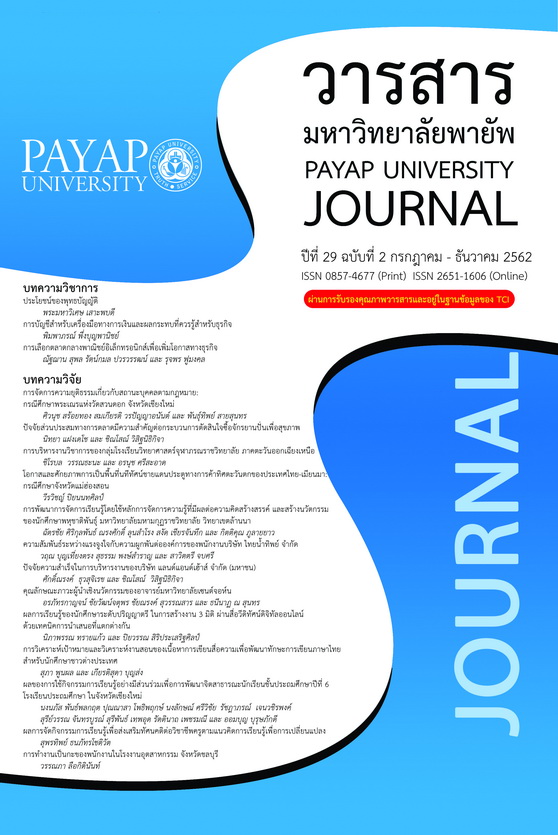การวิเคราะห์เป้าหมายและวิเคราะห์งานสอนของเนื้อหาการเขียนสื่อความ เพื่อพัฒนาทักษะการเขียนภาษาไทยสำหรับนักศึกษาชาวต่างประเทศ
Main Article Content
บทคัดย่อ
การศึกษาวิจัยครั้งนี้มีวัตถุประสงค์เพื่อวิเคราะห์เป้าหมายและการวิเคราะห์งานสอนของเนื้อหาการเขียนสื่อความ เพื่อพัฒนาทักษะการเขียนภาษาไทยสำหรับนักศึกษาชาวต่างประเทศ โดยใช้ระเบียบวิธีวิจัยเชิงคุณภาพ โดยได้นำผลการวิเคราะห์ไปให้ผู้เชี่ยวชาญตรวจสอบความเที่ยงตรงเชิงเนื้อหา
ผลการศึกษาพบว่า การวิเคราะห์เนื้อหาการเขียนสื่อความ จำแนกได้เป็น 2 ประเด็น คือ การวิเคราะห์เป้าหมาย และการวิเคราะห์งานสอน ในการวิเคราะห์เป้าหมาย จำแนกได้ 3 เป้าหมาย คือ นักศึกษาชาวต่างประเทศสามารถ 1) เรียงลำดับคำในประโยคได้ 2) ใช้คำเชื่อมโยงประโยคได้ และ 3) เขียนสื่อความในระดับย่อหน้าได้ในระดับดี ส่วนผลการวิเคราะห์งานสอน พบว่า สามารถนำเป้าหมายทั้งหมดมาวิเคราะห์วัตถุประสงค์เชิงพฤติกรรมได้ 28 วัตถุประสงค์ ประกอบด้วย วัตถุประสงค์ทักษะพื้นฐานซึ่งเป็นพฤติกรรมหรือความรู้เดิมของผู้เรียน มีจำนวน 7 วัตถุประสงค์ เป้าหมายที่ 1 นักศึกษาชาวต่างประเทศสามารถเรียงลำดับคำในประโยคได้ กำหนดให้เป็นวัตถุประสงค์ปลายทางที่ 1 มีวัตถุประสงค์เชิงพฤติกรรม จำนวน 5 วัตถุประสงค์ เป้าหมายที่ 2 นักศึกษาชาวต่างประเทศสามารถใช้คำเชื่อมโยงประโยคได้ กำหนดให้เป็นวัตถุประสงค์ปลายทางที่ 2 มีวัตถุประสงค์เชิงพฤติกรรม จำนวน 7 วัตถุประสงค์ และเป้าหมายที่ 3 นักศึกษาชาวต่างประเทศสามารถเขียนสื่อความในระดับย่อหน้าได้ในระดับดี กำหนดให้เป็นวัตถุประสงค์ปลายทางที่ 3 มีวัตถุประสงค์เชิงพฤติกรรม จำนวน 9 วัตถุประสงค์ ทั้งนี้ได้มีข้อเสนอแนะเพื่อเป็นแนวทางในการจัดการเรียนการสอนสำหรับนักศึกษาชาวต่างประเทศต่อไป
Article Details
เอกสารอ้างอิง
ชนิกา คำพุฒ. (2545). การศึกษาการใช้ภาษาไทยของนักศึกษาจีนวิชาเอกภาษาไทยชั้นปีที่ 4 สถาบันชนชาติยูนนาน สาธารณรัฐประชาชนจีน. วิทยานิพนธ์ปริญญามหาบัณฑิต (สาขาวิชาการสอนภาษาไทย) คณะศึกษาศาสตร์ มหาวิทยาลัยเชียงใหม่.
ชัยยงค์ พรหมวงศ์, สมเชาว์ เนตรประเสริฐ และสุดา สินสกุล. (2520). ระบบสื่อการสอน. กรุงเทพฯ: จุฬาลงกรณ์มหาวิทยาลัย.
นิภา กู้พงษ์ศักดิ์. (2555). ปัญหาการใช้ภาษาไทยของนักศึกษาต่างชาติ: กรณีศึกษานักศึกษาจีนมหาวิทยาลัยกรุงเทพ. วารสารรามคำแหง ฉบับมนุษยศาสตร์, 31(1), 123-138.
บุญชม ศรีสะอาด. (2537). การพัฒนาการสอน. กรุงเทพฯ: สุวีริยาสาสน์.
เยาวดี รางชัยกุล วิบูลย์ศรี. (2552). การวัดผลและการสร้างแบบสอบผลสัมฤทธิ์ (พิมพ์ครั้งที่ 8). กรุงเทพฯ: จุฬาลงกรณ์มหาวิทยาลัย.
รุ่งฤดี แผลงศร. (2560). ศาสตร์การสอนภาษาไทยในฐานะภาษาต่างประเทศ. กรุงเทพฯ: จุฬาลงกรณ์มหาวิทยาลัย.
วีณา วโรตมะวิชญ. (2530). การออกแบบการสอนอย่างมีระบบ. เชียงใหม่: ภาควิชาประถมศึกษา คณะศึกษาศาสตร์ มหาวิทยาลัยเชียงใหม่.
สถาบันภาษาไทยสิรินธร จุฬาลงกรณ์มหาวิทยาลัย. (2559). การทดสอบสมรรถภาพภาษาไทยสำหรับผู้พูดภาษาไทยเป็นภาษาต่างประเทศ, สืบค้นเมื่อ 3 ธันวาคม 2559. http://www.sti.chula.ac.th /thai-test/non-native.
สมพงศ์ วิทยศักดิ์พันธุ์. (2549). การสอนภาษาไทยในฐานะภาษาต่างประเทศ. เชียงใหม่: โรงพิมพ์มิ่งเมือง.
อาภรณ์ ใจเที่ยง. (2550). หลักการสอน (พิมพ์ครั้งที่ 4). กรุงเทพฯ: โอเดียนสโตร์.


